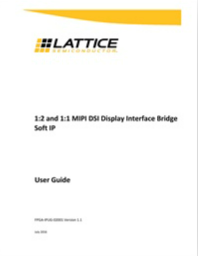1:2 and 1:1 MIPI DSI Display Interface Bridge Soft IP
As the industry evolves, bandwidth requirements have exceeded what display manufacturers are capable of manufacturing, while application processor vendors can provide very fast interfacing capabilities. For a cost effective solution, displays can later be replaced with newer display, with the processor retained. Also, multiple displays have gained popularity and extending the output to two display interfaces from a single source becomes a requirement to support these applications. The Lattice Semiconductor MIPI DSI to DSI Display Interface Bridge IP allows users to resolve these interfacing problems with the Lattice Semiconductor CrossLink™ programmable device.
Download thsi whitepaper to find out more.
Read More
By submitting this form you agree to [publishpress_authors_data field="display_name" post_id="$ID"] contacting you with marketing-related emails or by telephone. You may unsubscribe at any time. [publishpress_authors_data field="display_name" post_id="$ID"] web sites and communications are subject to their Privacy Notice.
By requesting this resource you agree to our terms of use. All data is protected by our Privacy Notice. If you have any further questions please email dataprotection@techpublishhub.com

